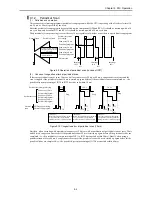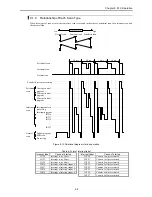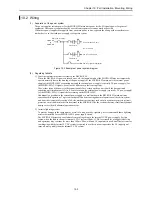
Chapter 9 PLC Operation
9-9
9.2
Online Change in RUN
The user programs can be modified during operation while retaining the output status as is. This is called the “program
change while running” function. To modify the user programs, special programming software or programmer is required.
Refer to the individual manuals on the operation.
Program change while running cannot be executed in the following situations. Perform this operation after satisfying the
conditions.
Table 9.4 Conditions for performing program change while running
No
Conditions under which
program change while
running cannot be performed
Specific situation
How to satisfy the conditions
1
When READ-occupying
Other programming device is connected.
Change other programming devices to off-line.
2
When a personal computer or panel, etc. is
connected and monitoring is being executed.
Change the personal computer or panel to off-line.
(When monitoring, it is convenient to use the
occupancy unnecessary task code.)
3
END instruction is not executed. A program that runs in an infinite loop is being
executed.
Correct the program so that it does not run in an
infinite loop.
4
Attempted to modify a program
that includes control
instructions.
Performing program change while running for a
circuit containing a control instruction may cause
operation to stop depending on the type of the
program modification error.
An explanation of how to perform program change
while running for a circuit that contains a control
instruction is given in the programming software
manual.
5
A password has been set.
A program protected by a password cannot be
modified.
Execute after having the system administrator
remove the password.
(When the CPU is stopped, the update is executed without displaying a message confirming program change while
running.)
The MICRO-EH operation when the user program is changed in RUN is shown below.
Note
The special internal output R7EF turns on during the transfer to the FLASH memory.
If the power supply to the CPU is turned off during transferring to the FLASH memory, the programs may be
destroyed. Before the power supply to the CPU is turned off it should be confirmed that R7EF is off, or it should
not be turned off until after approximately two minutes upon the completion of program transfer.
(If the pulse is being output, turn off the power supply
approximately two minutes after the pulse output stops.)
OK
NG
Scan resumes
Program change
while running
Scanning stops
at END scan
Program modification
Transfer to
FLASH memory
Assemble
check
Transfer to operation
execution memory
Error stop
(output shuts off)
HALT time
Program change
while running
including control
command
Displays that program change
while running is being performed
(programming device)
Figure 9.16 Internal processing for program change while running
Transfer to the FLASH memory
Unlike the conventional H/EH series, the MICRO-EH transfers its user program to the FLASH memory, the backup
memory, during the idle time of the CPU processing. Because of this, when the transfer to the operation execution
memory is completed, the peripheral unit displays that the transfer is complete. However, the transfer to the FLASH
memory is not completed at this stage. If the power supply to the CPU (especially CPUs without battery or CPUs whose
data maintenance guarantee time is over) is turned off at this status, a user memory error (31H) occurs when the power
supply to the main unit is turned back on. Therefore, it should be confirmed that the FLASH memory writing flag
(R7EF) is off before the power supply to the main unit is turned off, or it should not be turned off until after
approximately two minutes upon the completion of program transfer. (During pulse output, programs are not transferred
to the FLASH memory until the pulse output is stopped. If the pulse is being output, turn off the power supply
approximately two minutes after the pulse output stops.)
CPU HALT time
When performing program change while running, the program to be written to the CPU is checked if there are no errors,
then the CPU is halted temporarily (RUN
→
HALT).
The program of the modified area is written to the CPU while it is halted, and the CPU is set to operate (HALT
→
RUN)
again.
At this time, the following equation shows the approximate time the CPU is halted (it is not necessarily the maximum value).
HALT time (ms) = 45
×
Program capacity (k steps) + 20
An example of a calculation of the HALT time for the MICRO-EH using the above equation is 155 ms.
Содержание HIDIC MICRO-EH
Страница 1: ...HITACHI PROGRAMMABLE CONTROLLER APPLICATION MANUAL NJI 350B X ...
Страница 12: ...MEMO ...
Страница 14: ...Chapter 1 Features 1 2 MEMO ...
Страница 50: ...Chapter 4 Product lineup and wiring 4 18 MEMO ...
Страница 196: ...Chapter 5 Instruction Specifications 5 146 ...
Страница 263: ...Chapter 11 Communication Specifications 11 10 MEMO ...
















































